
Home » Finnish Lapphund – A Rainbow of Colors
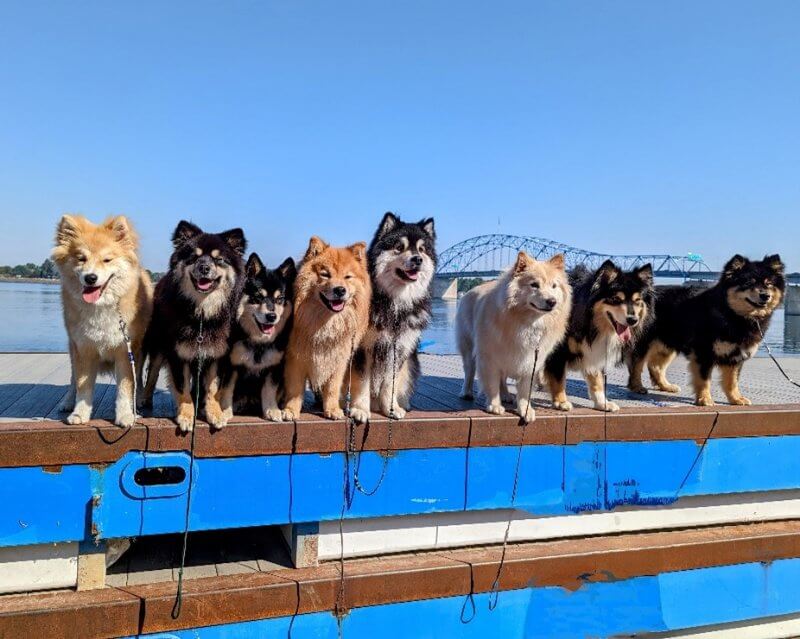
The first thing people notice when they watch Finnish Lapphunds ringside is the array of colors and markings. Lappies (what we affectionally call the breed) should be easily recognizable, but they are not a cookie-cutter breed.
Each dog is unique in its own way because of its color and markings, with few Finnish Lapphunds having identical markings. The Sami people who bred these dogs valued the diversity of colors and traditionally named their dogs based on its coat color and texture.
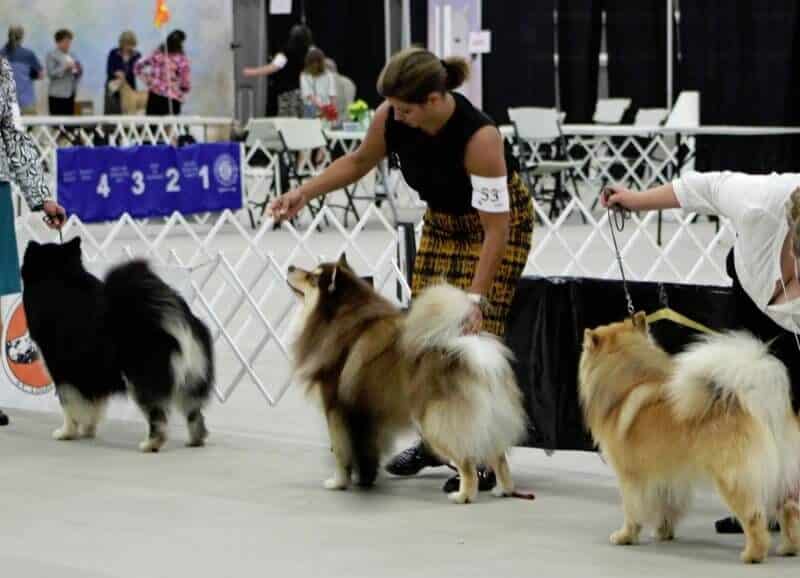
The AKC Breed Standard states: “All colors are permitted, but the primary color (the color which covers the largest portion of the dog) must cover the body. A color which consists of bands of different colors on a single hair shaft (sable, wolf sable, or domino) is considered a single color. Secondary colors are allowed on the head, neck, chest, underside of the body, legs, and tail.”
In Finnish Lapphunds, there are a lot of color options and combinations. No single color is considered ideal, although there are some colors which are more common than others. Color is defined as a single primary color on the body, with secondary color or colors allowed on the head, neck, chest, belly, legs, feet, or tail. The primary color must cover at least 51 percent of the dog.
Finnish Lapphunds can be sable, wolf sable, tan point, solid, or domino. Common solid colors are black, brown, or cream. The whole color combo will be hidden if the dog is cream. They can also come with a light undercoat which can make identification of the color of the adult coats more difficult. Identification of the color can also be affected by whether or not the dog is in full coat or out of coat.
Any color can have white markings, typically on the chest, belly, and feet, along with lighter spectacles around the eyes. Dogs with noticeable white markings, plus tan pattern markings, are called “tri-color” in England. In Finland, extensive white markings often go without any mention at all.
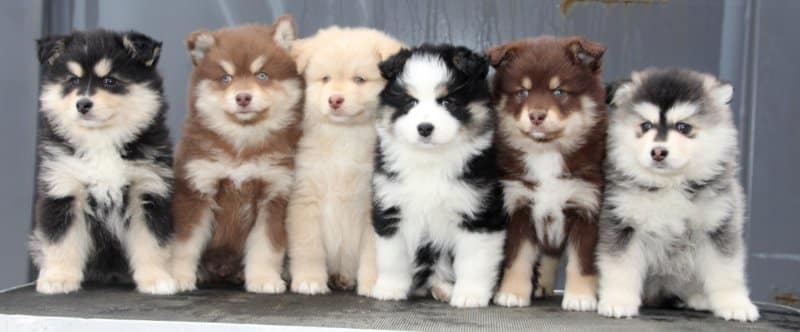
The image above shows a litter of Finnish Lapphund puppies that produced four colors, with a variety of color intensity and markings. Eye color, nose pigment, tan intensity, and markings can change as the puppies mature.
This photo is from the Kalo Skilo “James Bond litter.” Breeder is Maria Knudsen of Norway. Photographer is Rita Bekkeli. From left to right:
Since all colors are allowed, labeling the colors is a way Lappy people (like the Sami people) can identify a dog. Like the Sami people, Lappy people also describe and identify the dogs by color. Here are the common descriptions of various colors:
Black is the most common color, usually with tan point markings (often referred to as Black and Tan), and is the most-recognized color for the breed. Tan intensity varies from pale cream to deep caramel.
Brown Finnish Lapphunds are found in various shades, with or without Tan or White markings. Browns lack black pigment and will have a brown nose, eye rim, lip, and pad pigment. Browns can range from light brown to chocolate to reddish brown. In Finland, the brown color is called Ruskea (brown) or Parkki (tree bark).
Creams mask every other color. The pigment color on the nose, eye rims, lips, and feet give away the base color of Black or Brown. Pigment often fades on Cream Finnish Lapphunds, especially on the nose, and even more so over the winter.
Black Wolf Sable have individual hair shafts with three or more bands of color, always starting with black at the base and ending with black at the tip. The alternating color is lighter, usually a shade of tan. They can also be seen with tan point masks, but without the signature eyebrow pips. The actual color can be difficult to identify at birth, and as adults, the sable (black tip) guard hairs can cover the body, giving the appearance of a Black and Tan dog.
Brown Wolf Sable is less common, with the individual hair shafts having three or more bands of color of various shades of brown. The alternating color is a lighter shade of tan. There are many registered “Brown” Finnish Lapphunds that are actually suspected to be Brown Wolf Sables. The Wolf Sable can sometimes be hard to detect without a DNA color test, especially on an adult.
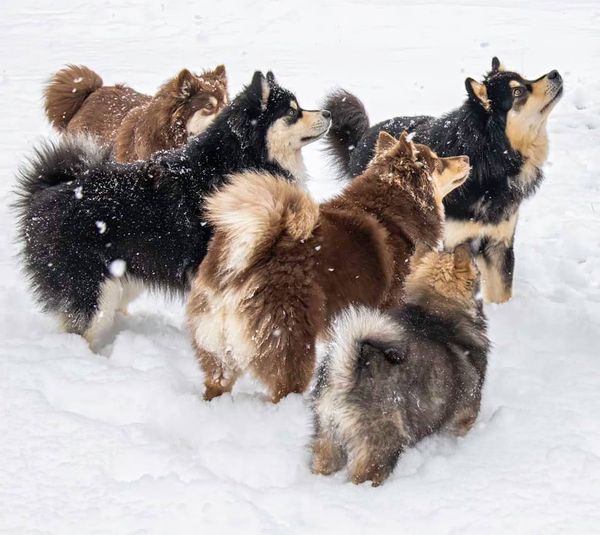
Sables range in color from pale cream to deep red/orange. Black or Brown pigment and sable tips gives away the base color. The pigment is often retained and doesn’t fade over time like it does on Creams. Calling a dog a Black Sable can confuse people when what they see is a tan/brown/reddish-colored dog.
The color intensity varies, but the brown tips and pigment give away the brown base color. These can be much harder to identify, but one parent must be a Sable in order to produce any Sable.
The recessive dilute gene on a Black dog produces Blue. While fairly obvious in a puppy, as adults it’s often difficult to distinguish between Black and Blue. This color is uncommon.
The recessive dilute gene on a Brown dog produces Lilac. Due to the recessive nature of both Brown and Dilute, this color is also uncommon.
Similar to Cream, Domino Black actually alters the appearance of the other colors by applying a base color (black, brown, dilute) pattern overlay. Distinctly different when they are born, this color can be difficult to distinguish from a Black and Tan at maturity, depending on how dark it is. The coat is predominately white, with black (or brown or blonde) tips on the longer body coat. The tips may be very long, more than two-thirds of the hair shaft, making the dog look like it has a black body coat until you part the hair to view the white “roots.” All Domino dogs have white on their face, legs, and tail.
In Domino Brown, you’re looking for the color of the tips; not to be confused with the cream/caramel tan point markings.
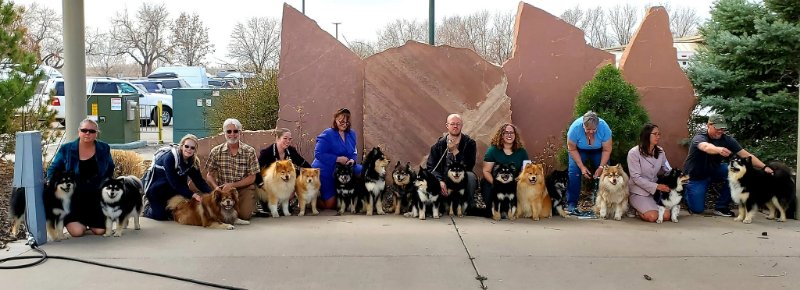
The traditional signature look of the Lappies includes a tan point mask (similar to a wolf mask). Some are full and bright with clear edges, others are less distinct. Lappies can also develop spectacles (like wire rim glasses) around the eyes. These can be in addition to a mask or entirely separate. Lappies often have distinctive eyebrows or pips. Markings on the face vary tremendously, and every pattern or variation is equally accepted, with no one look preferred over another. Tan point markings are not required, and single-color dogs should never be faulted for their solid color.
Eye color should be as dark as possible. While dark brown eyes are considered the ideal, coat color affects the eye color, with Brown and Dilute-colored Lappies often having a lighter eye, usually complementing the coat color. Blue eyes are not desired in a Lappy and are very rare.
Nose leather color, like eye color, should be as dark as possible but is affected by the coat color. A Butterfly or Snow nose has a paler stripe down the center of the nose leather, with less pigment. Butterfly noses are common and tolerated, but are not preferred. Cream dogs often have pale or flesh-colored noses.
Irish Spotting White markings can occur on any color; usually on the chest, belly, legs, feet, and tail. White can extend up to the face, back of neck, or even a full collar. Full body white with patches of color is not desirable for the show ring and is uncommon. White shouldn’t be more than 25 percent of the coat.
A tan dog with a large patch of black on its back, similar to the color often seen in German Shepherd Dogs. In this case, the secondary color, black, is present in an unacceptable area on the back.
A white dog with patches of a secondary color. Again, the secondary color is on the body, which is undesirable.
“Stripes” of tan alternating with black. Because of the long coat, this color often looks rather mottled. Individual hair shafts are one color or the other, so this is not considered to be a solid color.
This color does not exist in the breed.
One of the ways today’s judges, breeders, and exhibitors can honor the traditions of the past is to recognize and preserve the rainbow of colors of the Finnish Lapphunds. As the Sami people value the unique individuality of the color, appearance, and behavior of these dogs, so should the dog world.
The best way to ensure a long and happy relationship with a purebred dog is to purchase one from a responsible breeder. Not sure where to begin finding a breeder? Contact the National Parent Club’s Breeder Referral person, which you can find on the AKC Breeder Referral Contacts page.
Did you know nearly every recognized AKC purebred has a dedicated rescue group? Find your new best friend on the AKC Rescue Network Listing.
Showsight Magazine is the only publication to offer dedicated Digital Breed Magazines for ALL recognized AKC Breeds.
Read and learn more about the loyal Finnish Lapphund dog breed with articles and information in our Finnish Lapphund Dog Breed Magazine.
Error embedding FlippingBook shortcode, please check the flipbook url. (https://digital.showsightmagazine.com/view/425017/)
